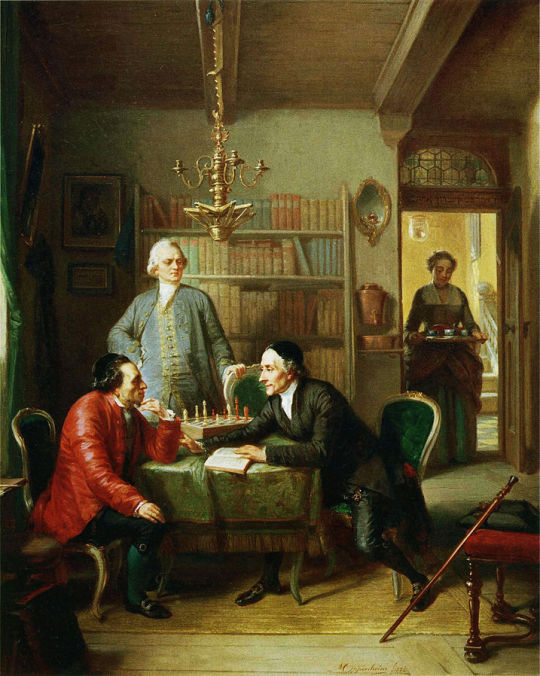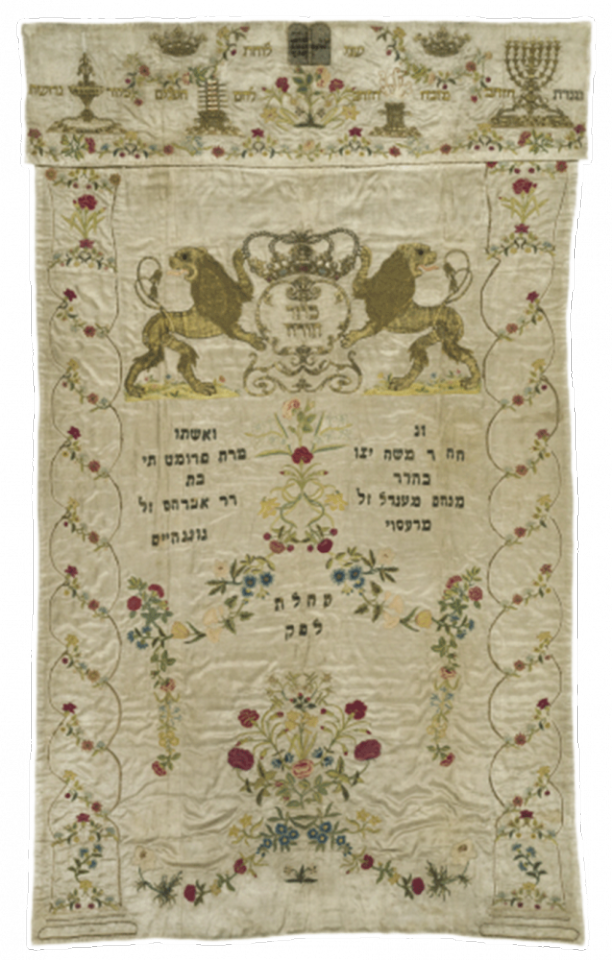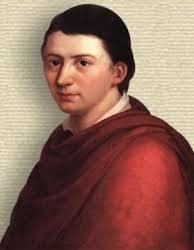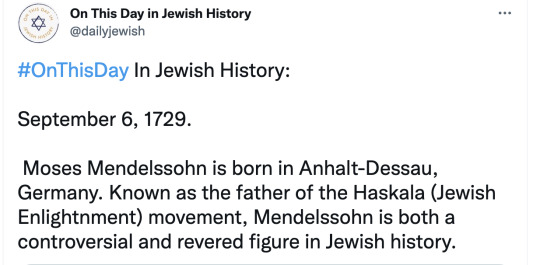#moses mendelssohn
Text
Thinking about the death of Mendelssohn again because I get to do a presentation on the Pantheism Controversy for class. And. It's just so meaningful.
I'm pretty consistent in my conviction that Mendelssohn and Lessing were the only two straight men in the Aufklärung. But one of the reasons they wrote so beautifully about the Power of Friendship is because they had experienced it firsthand with each other. According to Altmann, Mendelssohn was responsible for Lessing's philosophical/rhetorical development. And Lessing helped Mendelssohn find the platform (and the confidence) to share his writing with the public. Neither is entirely conventional in their beliefs—Lessing was an ex-PK who rejected organized religion altogether and Mendelssohn spent his teenage years concealing his shameful double life of Reading German Books from the community leaders upon whom his life and safety depended. Both men *got* each other, and although they drifted apart as they aged, each knew they could depend on the other to accept him when he was pushed aside by 18th-century Prussian society's demands for obedience and conformity.
So when Lessing is posthumously, publicly accused of Spinozism, Mendelssohn knows he needs to stand up for the friend who can no longer defend himself in print. He runs himself ragged writing polemic—a style Lessing preferred in his youth—and on the last day of 1785 gets horribly sick delivering it to the press. While he had suffered from various physical/immune disabilities since his youth, Knobloch claims that the stress and exposure of this final delivery is what killed him.
Lessing and Mendelssohn entered the public sphere together, and they left it together: Lessing's last great work, Nathan the Wise, is often read as being inspired by Mendelssohn*, while Mendelssohn’s final writing is literally called "to Lessing's Friends." And while the 18th century produced some fascinating romantic entanglements—Voltaire and du Châtelet, Voltaire and F2, Gleim and Kleist and Karsch, Goethe and Schiller (?) etc, I cannot name anyone but Herr Moses who died in defense of the people they loved.
#moses mendelssohn#gotthold ephraim lessing#mendelssohn#Lessing#comings and goings of men#herr moses in berlin#studia felicitatis
12 notes
·
View notes
Text

Körperbau wie eine Legende
3 notes
·
View notes
Text

Moritz Daniel Oppenheim (German, 1800–1882) Levator and Lessing as guests in the home of Moses Mendelssohn (1856)
2 notes
·
View notes
Photo

0 notes
Text
No Religion without Idolatry by Gideon Freudenthal
No Religion without Idolatry by Gideon Freudenthal
Mendelssohn’s Jewish Enlightenment
Moses Mendelssohn (1725–1786) is considered the foremost representative of Jewish Enlightenment. In No Religion without Idolatry, Gideon Freudenthal offers a novel interpretation of Mendelssohn’s general philosophy and discusses for the first time Mendelssohn’s semiotic interpretation of idolatry in his Jerusalem and in his Hebrew biblical commentary.…

View On WordPress
0 notes
Text
if there is no G-d, why stay Jewish in practice?
An interesting question I saw in a Facebook group. Some of my favorite responses that resonated for me:
"It's still the mythological language that feels authentic to me, and I still need love it and crave it in a pre-rational part of my self."
"God might not exist but the Jewish people definitely do."
"At no point in my life has believing in g-d felt like a requirement for my Judaism. Judaism has always, for me, been more about philosophy, practice, ritual, justice, community, and action. The concept that any religion doesn't have meaning or value without belief in a deity is really foreign to me and kind of strikes me as a Christianity-derived idea."
"Rabbi Moses Mendelssohn wrote that in contrast to protestantism, which values faith above all, Judaism values practice above all. He suggested being Jewish one needn't be theistic at all."
#jewish#judaism#jumblr#ritual#my personal journey#faith#orthodoxy vs orthopraxy#mitzvot#atheism#theism#theology
656 notes
·
View notes
Note
any recs for intro/base level jewish study texts? np if they’re academic ones I can use my uni’s library :-)
oooo okay. fair warning my minor is history so a lot of this is history focused but there are a lot of modern Jewish studies as well! like intersections w queerness and feminism etc. it is just not my wheelhouse.
starting w some comparative religion is always a solid base when it comes to academics bc some of the first classes are like world religions etc. it has been so long that i do Not remember which one i used but really any "intro to world religions" textbook that your uni's library has is good! and if you want to just focus on the section about Judaism go for it. looking at Christianity and Islam might also be helpful though to put it into some context.
A Short History of the Jewish People: From Legendary Times to Modern Statehood by Raymond P. Scheindlin is excellent. here if you want to dig deeper whenever it mentions a Jewish thinker/scholar, try and find some primary resources of their writings! like Moses Maimonides, possibly the most influential Jewish philosopher, or Moses Mendelssohn (another philosopher and theologin).
Genesis, Exodus, and Deuteronomy. if you wanna go the extra mile go for the whole Torah (so Leviticus and Numbers as well), but these three do a solid job of giving a good idea of the more non-historical aspect of Jewish religious history and will give you a good idea of where a lot of customs, laws, etc came from. of particular note are gonna be the two accounts of the Sinai event in both Exodus and Deuteronomy and ask yourself: why do they differ? why do you think that is? what could this tell you about Judaism and the ancient Israelites when each account was written?
I have not read it but Wanderings by Chaim Potok is a highly recommended one outside of academia and one that I know some goyim have read as well to better understand Jewish history. however I haven't read it so I don't know if there's any issues with it as it is an older work.
another one i see around a lot outside of academics is The Jewish Book of Why by Alfred J. Kolatch. this one is less history and more, as the title says, a book about Why and ritual/custom/etc.
more intermediate/deeper dives
this is my own personal niche so if you do not care about this you can ignore this section but I find it so interesting and useful/helpful to look at just How Judaism evolved and some good ones for that are The Origins of Biblical Monotheism by Mark S. Smith and as much as I have some beef w the man Jan Assmann is going to crop up a Lot in these types of discussions so giving him a read is useful, particularly Moses the Egyptian and The Price of Monotheism. give it a critical read though, I personally disagree w a lot of his conclusions but I find his work and history he gives to be of note & worthwhile. you might find you do totally agree and that's fine too.
continuing off of That i personally think the Ugaritic texts are incredibly important in understanding the context of the ancient Israelite religion that came before Judaism and thus Judaism itself and so if you're interested more in that type of ancient history when it comes to Jewish studies giving them a read is really eye-opening bc it gives you an idea of what sort of cultural knowledge was assumed by the writers of the Tanakh. like they were writing it with the assumption that their readers would Know these stories that were shared in this region so reading them is super helpful with putting certain customs/belief into context. but that's more of a lil deep dive so if you don't wanna do that you absolutely do not have to. rn i'm reading Stories From Ancient Canaan by Michael D. Coogan and Mark S. Smith
#long post#religious studies rambling#ignore my plurality typo there for a minute i changed a few words and forgot to change the conjugation <3
9 notes
·
View notes
Text
Beard Styles
Beard hair is most commonly removed by shaving or by trimming with the use of a beard trimmer.
If only the area above the upper lip is left unshaven, the resulting facial hairstyle is known as a mustache;
if hair is left only on the chin, the style is a goatee.
Goatee: A tuft of hair grown on the chin, sometimes resembling a billy goat's.
Junco: A goatee that extends upward and connects to the corners of the mouth but does not include a mustache, like the circle beard.
Meg: A goatee that extends upward and connects to the mustache, this word is commonly used in the south east of Ireland.
Van Dyke: a goatee accompanied by a mustache.
Monkey tail: a Van Dyke as viewed from one side, and a Lincoln plus mustache as viewed from the other, giving the impression that a monkey's tail stretches from an ear down to the chin and around one's mouth.
Hollywoodian: a beard with an integrated mustache that is worn on the lower part of the chin and jaw area, without connecting sideburns.
Reed: a beard with an integrated mustache that is worn on the lower part of the chin and jaw area that tapers towards the ears without connecting sideburns.
Royale: a narrow pointed beard extending from the chin. The style was popular in France during the period of the Second Empire, from which it gets its alternative name, the imperial or impériale.
Verdi: a short beard with a rounded bottom and slightly shaven cheeks with a prominent mustache
Muslim beard: Full beard with the mustache trimmed
Soul patch: a small beard just below the lower lip and above the chin
Glitter beard: Beard dipped in glitter.[20][21]
Hulihee: clean-shaven chin with fat chops connected at the mustache.
Friendly mutton chops: long mutton chop-type sideburns connected to a mustache, but with a shaved chin and neck.
Stashburns or the Lemmy: sideburns that drop down the jaw but jut upwards across the mustache, leaving the chin exposed. Similar to friendly mutton chops. Often found in southern and southwestern American culture (see, for example, the Yosemite Sam caricature).
Closed or Tied beard: Mostly seen among modern Sikh youth, this is a kind of full beard tied by using a sticky liquid or Gel and stiffens below the chin.
Oakley beard: Described by Indian makeup artist Banu as "neither a French beard nor a full beard". She used the look for Rajinikanth in Enthiran (2010).
Full: downward flowing beard with either a styled or integrated mustache
Garibaldi: wide, full beard with rounded bottom and integrated mustache
Old Dutch: A large, long beard, connected by sideburns, that flares outward in width at the bottom, without a mustache.
Sideburns: hair grown from the temples down the cheeks toward the jawline. Worn by Ambrose Burnside (the namesake of the style), Isaac Asimov and Carlos Menem.
Jawline beard: A beard that is grown from the chin along the jawline. Chinstrap, chin curtain and brett are all variations of a jawline beard with distinctions being chin coverage and sideburn length.
Chinstrap: a beard with long sideburns that comes forward and ends under the chin.
Chin curtain: similar to the chinstrap beard but covers the entire chin. Also called a Lincoln, Shenandoah, or spade.
Brett: similar to the chin curtain beard, but does not connect to the sideburns.[17]
Neckbeard: similar to the chinstrap, but with the chin and jawline shaven, leaving hair to grow only on the neck. While never as popular as other beard styles, a few noted historical figures have worn this type of beard, such as Nero, Horace Greeley, Henry David Thoreau, William Empson, Peter Cooper, Moses Mendelssohn, Richard Wagner, and Michael Costa.
Circle beard: Commonly mistaken for the goatee, the circle beard is a small chin beard that connects around the mouth to a mustache. Also called a doorknocker.[18]
Designer stubble: A short growth of the male beard that was popular in the West in the 1980s, and experienced a resurgence in popularity in the 2010s.[19]
Sea captain: A rounded, bottom-heavy beard of medium length with short sides that is often paired with a longer mustache.
3 notes
·
View notes
Text

GERÇEK BİR HİKÂYE
Moses Mendelssohn hiç yakışıklı bir adam değildi. Çok kısa boyunun olmasının yanı sıra, çok garip bir de kamburu vardı. Moses Mendelssohn, günün birinde Hamburg da yaşayan bir işadamını ziyarete gitti. İşadamının, Frumtje adında çok güzel bir kızı vardı. Moses, bu güzel kıza umutsuz bir aşkla tutuldu. Fakat güzel kız onun çirkin görün...tüsünden ürkmüştü. O nedenle, değil onun sevgisine karşılık vermek, yüzüne bile bakmak istemiyordu. Ayrılma zamanı geldiğinde Moses, güzel kızın üst kattaki odasına çıktı ve tüm cesaretini toplayarak onunla son kez konuşma girişiminde bulundu. Kızın güzelliği öylesine olağanüstüydü ki, bir an için onun cennetten geldiğini bile düşündü. Fakat kızın, başını kaldırıp da yüzüne bakmamaktaki direnci, Moses i çok üzdü. Güçlükle başarabildiği konuşması sırasında çirkin aşık, bu güzel kıza bir soru sordu: "Evliliklerin kutsal bir özelliği olduğuna inanır mısınız?" dedi. "Elbette" diyerek yanıtladı güzel kız ve gözlerini yine kaldırmayıp Moses in yüzüne yine bakmadan, kendi de ona bir soru sordu: "Peki ya siz?"dedi."Siz inanır mısınız buna?" Moses bir an bile duraksamadı: "Evet,ben de inanırım" dedi ve ekledi: "Biliyor musunuz? Her erkek çocuğu doğduğunda Tanrı,onun evleneceği kızı belirlermiş. Benim doğumumda da,benim evleneceğim kız belirlenmiş ve bana Senin karın kambur olacak demiş.O zaman ben bir istekte bulunmuşum Tanrı dan. Tanrım, kambur bir kadın bir trajedi olur. Lütfen onun kamburluğunu bana ver ve onu güzel bir kadın yap demişim." Moses in bu sözlerinden sonra Frumtje gözlerini yerden kaldırdı, onun gözlerinin içine baktı ve elini uzatIp, Moses in elini tuttu.Ve daha sonra da onun, sevgili eşi oldu.
(Bu anlatılanlar bir "peri masalı" değil, ünlü Alman besteci Mendelssohn un büyükbabası ile büyükannesinin evlenmelerinin öyküsüdür.)
39 notes
·
View notes
Text
Giggling and twirling my hair whenever the Prof of my 18th-century German-Jewish Studies course brings up Moses Mendelssohn. It's like I'm back in middle school and the other kids are teasing me with the name of my crush. My best friend tells them to knock it off, we're here to learn, not to talk about sherb's blorbo. To learn you say
7 notes
·
View notes
Text
tagged by @hasdrubal-gisco against my will
Last song: placebo - big mouth strikes again (The Smiths cover)
Currently watching: the sopranos
Currently reading: Aleksandar Tišma - Mrtvi ugao, Roger Pearson - Voltaire Almighty: A Life in Pursuit of Freedom
Sweet/savoury/spicy: sweet. fuck what my diabetes-prone genetics say
Relationship status: you cannot possibly fathom how single i am
Current obsessions: i am normal and simply dont have those. i interact with my environment in a non-obsessive manner
Last thing i googled: "Mendelssohn Jerusalem"
Currently working on: an essay for a PhD course about Moses Mendelssohn and Moses Hess
tagging @bajecna @samuraibydjavan @regularkiwi im sorry for the notif if you dont feel like doing it i understand
3 notes
·
View notes
Text
”Os morirías de angustia si, como exigís, el mundo en su totalidad se volviera de veras comprensible”
Friedrich Schlegel

Karl Wilhelm Friedrich Von Schlegel fue un filósofo, crítico literario, historiador, filólogo clásico y traductor alemán nacido en Hannover en marzo de 1772, considerado uno de los mas importantes junto con su hermano August del circulo de Jena.
Fue el más joven de una familia protestante de 6 hermanos.
Destinado a convertirse en banquero, rechazó la vocación con la finalidad de estudiar derecho en la universidad de Gotinga y posteriormente en Leipzig, en donde comenzó a interesarse en la cultura griega viajando en 1794 a la ciudad de Dresde en donde estudió arte y cultura grecolatina clásica escribiendo su ensayo Sobre el estudio de la poesía griega.
En Jena (en donde su hermano August Wilhelm impartía clases), empezó a desarrollar en estética, lo que constituiría el principio teórico del romanticismo, la ironía romántica o dicotomía, entre la obra creada e imperfecta, y la idea de su autor perfecta.
Desarrolló el concepto de “Poesía universal progresiva”, que reúne diversos géneros literarios en donde establece que el arte se expresa a partir de su propio fracaso y utiliza a la ironía para reflexionar sobre el mismo, separándose del concepto “Clásico” armónico y cerrado que representaba un estado ideal.
Con lo anterior Schlegel conduce a la posibilidad de concebir una poesía trascendental, entendida como condición de posibilidad de una poesía que sea, a la vez poesía de la poesía.
Junto con su hermano, y el escritor y hispanista aleman Ludwik Tieck, fundaron la revista Ateneo, que fungió como órgano del movimiento romántico alemán, y cuya edición duró de 1798 a 1800.
Fue durante esos años que Friedrich escribió la novela autobiográfica e inacabada Lucinda en 1799, y en 1800, su obra más amplia sobre estética romántica “Gespräch über die Poesie” en donde destaca como las figuras más importantes de la literatura universal a Dante Alighieri, Miguel de Cervantes y William Shakespeare.
En 1804 se casó con Dorothea Vent, (pariente del filósofo judío Moses Mendelssohn) con quien viviría en París, lugar en donde también aprendería el sánscrito y fundaría el periódico “Europa”.
Tras convertirse al catolicismo él y su esposa, viajaron a Viena en 1808, en donde trabajó en el ministerio de asuntos exteriores austriaco, sirviendo al ejército de 1809 a 1810.
Aplicando la filología comparada al indoeuropeo, (de la que se considera pionero), proclamó que la India era la cuna de la civilización occidental, basado en las observaciones del lingüista e investigador Sir William Jones y las similitudes encontradas entre el sánscrito y otras lenguas como el latín, griego y persa.
Para Schlegel, la ironía se vuelve un elemento constitutivo de la producción humana, tanto comprensible como incomprensible, manifestando que “Puesto que todo se ha fraguado al calor de la ironía, no puedo desmentirla, pues hacerlo implicaría contravenirla”.
La amenaza de que todo se volviera comprensible es, para Schlegel, olvidar que el mundo, como sostenían los griegos, devino del caos y la incomprensibilidad al orden y la comprensión.
Schlegel fue un incomprendido de su tiempo, el siglo XIX no lograría entender la propuesta de Schlegel y la ironía, quedando como un concepto que reproduce categorías idealistas en términos poéticos o un movimiento antirracionalista que habría reaccionado contra la ilustración.
Friedrich Schlegel fallece de un accidente cerebrovascular en Dresde en enero de 1829 a la edad de 56 años.
Fuentes: Wikipedia, Teseopress y Encyclopaedia Herder
#filosofos#friedrich schlegel#notasfilosoficas#citas de reflexion#frases de reflexion#notas filosoficas#frases de filosofos#filosofando#filologia#frases de escritores
3 notes
·
View notes
Text

GERÇEK BİR HİKÂYE
Moses Mendelssohn hiç yakışıklı bir adam değildi. Çok kısa boyunun olmasının yanı sıra, çok garip bir de kamburu vardı. Moses Mendelssohn, günün birinde Hamburg da yaşayan bir işadamını ziyarete gitti. İşadamının, Frumtje adında çok güzel bir kızı vardı. Moses, bu güzel kıza umutsuz bir aşkla tutuldu. Fakat güzel kız onun çirkin görün...tüsünden ürkmüştü. O nedenle, değil onun sevgisine karşılık vermek, yüzüne bile bakmak istemiyordu. Ayrılma zamanı geldiğinde Moses, güzel kızın üst kattaki odasına çıktı ve tüm cesaretini toplayarak onunla son kez konuşma girişiminde bulundu. Kızın güzelliği öylesine olağanüstüydü ki, bir an için onun cennetten geldiğini bile düşündü. Fakat kızın, başını kaldırıp da yüzüne bakmamaktaki direnci, Moses i çok üzdü. Güçlükle başarabildiği konuşması sırasında çirkin aşık, bu güzel kıza bir soru sordu: "Evliliklerin kutsal bir özelliği olduğuna inanır mısınız?" dedi. "Elbette" diyerek yanıtladı güzel kız ve gözlerini yine kaldırmayıp Moses in yüzüne yine bakmadan, kendi de ona bir soru sordu: "Peki ya siz?"dedi."Siz inanır mısınız buna?" Moses bir an bile duraksamadı: "Evet,ben de inanırım" dedi ve ekledi: "Biliyor musunuz? Her erkek çocuğu doğduğunda Tanrı,onun evleneceği kızı belirlermiş. Benim doğumumda da,benim evleneceğim kız belirlenmiş ve bana Senin karın kambur olacak demiş.O zaman ben bir istekte bulunmuşum Tanrı dan. Tanrım, kambur bir kadın bir trajedi olur. Lütfen onun kamburluğunu bana ver ve onu güzel bir kadın yap demişim." Moses in bu sözlerinden sonra Frumtje gözlerini yerden kaldırdı, onun gözlerinin içine baktı ve elini uzatIp, Moses in elini tuttu.Ve daha sonra da onun, sevgili eşi oldu.
(Bu anlatılanlar bir "peri masalı" değil, ünlü Alman besteci Mendelssohn un büyükbabası ile büyükannesinin evlenmelerinin öyküsüdür.)
18 notes
·
View notes
Text
Let us linger a few moments over Kant's text. It merits attention for several reasons.
A. To this same question, Moses Mendelssohn had also replied in the same journal, just two months earlier. But Kant had not seen Mendelssohn's text when he wrote his. To be sure, the encounter between
the German philosophical movement
the new development of Jewish culture
does not date from this precise moment. Mendelssohn had been at that crossroads for thirty years or so, in company with Lessing.
1. But, up to this point it had been a matter
of making a place for Jewish culture within German thought – which Lessing had tried to do in Die Juden
or else of identifying problems common to Jewish thought and to German philosophy; this is what Mendelssohn had done in his Phadon; oder, Über die Unsterblichkeit der Seele [Phadon; or, On the Immortality of the Soul]
2. with the two texts published in the Berlinische Monatschrift
the German Aufklärung and the Jewish Haskala recognize that they belong to the same history
they are seeking to identify the common processes from which they stem
and it is perhaps a way of announcing the acceptance of a common destiny – we now know to what drama that was to lead
– Michel Foucault, What is Enlightenment? (part II: Kant's text), in Rabinow (P.), éd., The Foucault Reader, 1984
2 notes
·
View notes
Audio
HAPPY BIRTHDAY to Stig Anderson (ABBA), Corazon Aquino, Bellini’s 1835 opera I PURITANI, Robert Burns, William Cavendish, John Cooper Clarke, Michael Cotton (The Tubes), Andy Cox (Fine Young Cannibals), Rusty Draper, James Erb, Wilhelm Furtwängler, Benny Golson, Malcolm Green (Split Enz), Kitahara Hakushū, George Harrison’s 1988 “When We Was Fab” single, Etta James, Alicia Keys, Harold Lloyd, Jr., Witold Lutosławski, Ewan MacColl, Shirley Mason a.k.a. “Sybil,” W. Somerset Maugham, Mendelssohn’s 1858 “Wedding March,” Florence Mills a.k.a. The Queen of Happiness, Toše Proeski, Jan Sandström, Floyd “Guitar” Smith, Moses “Whispering” Smith, Kurt Stenzel, Edmund Sylvers, Gary Tibbs (Roxy Music), Timothy White, Haini Wolfgramm (The Jets), and the great, quick-study and rock-steady drummer Bill Matlack, Jr. I joined Bill on the stage many times, with Ben Kaplan, Neon Cactus, and others. Bill also played on my FIRE album and several other notable recordings—including this one with Davy Jones (Monkees), the gospel-pop anthem “When All Else Fails.” Meanwhile, HB BM and thank you for keeping us on the beat. https://johnnyjblairsingeratlarge.bandcamp.com/track/when-all-else-fails
#billmatlack #drummer #davyjones #monkees #gospel #pop #johnnyjblair #benkaplan #neoncactus #countryrock #williamsport #pennsylvania
2 notes
·
View notes


